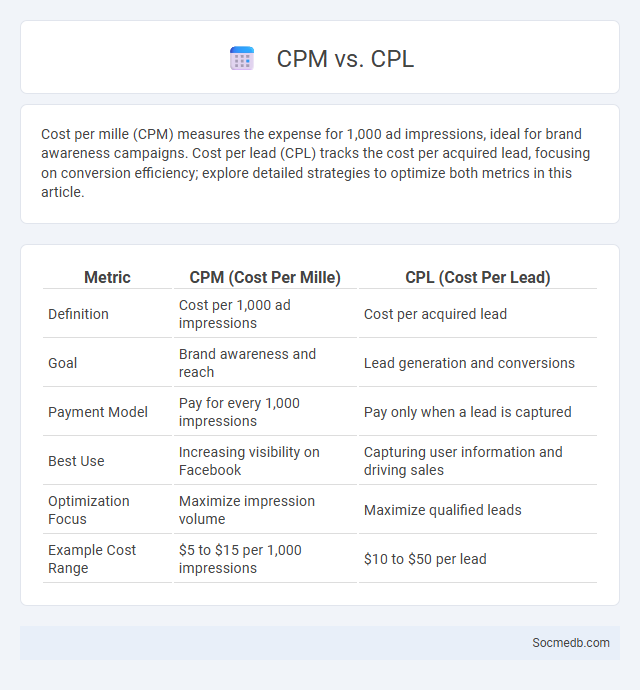
Photo illustration: CPM vs CPL
Cost per mille (CPM) measures the expense for 1,000 ad impressions, ideal for brand awareness campaigns. Cost per lead (CPL) tracks the cost per acquired lead, focusing on conversion efficiency; explore detailed strategies to optimize both metrics in this article.
Table of Comparison
| Metric | CPM (Cost Per Mille) | CPL (Cost Per Lead) |
|---|---|---|
| Definition | Cost per 1,000 ad impressions | Cost per acquired lead |
| Goal | Brand awareness and reach | Lead generation and conversions |
| Payment Model | Pay for every 1,000 impressions | Pay only when a lead is captured |
| Best Use | Increasing visibility on Facebook | Capturing user information and driving sales |
| Optimization Focus | Maximize impression volume | Maximize qualified leads |
| Example Cost Range | $5 to $15 per 1,000 impressions | $10 to $50 per lead |
Understanding CPM, CPL, and Ad Auctions
CPM (Cost Per Mille) measures the cost to reach one thousand impressions, helping you gauge the efficiency of your social media ad spend. CPL (Cost Per Lead) focuses on the expense to acquire a lead, crucial for evaluating campaign effectiveness in generating potential customers. Ad auctions determine which ads appear based on factors like bid amount, ad quality, and relevance, ensuring your budget targets the most valuable audience efficiently.
Key Differences Between CPM and CPL
CPM (Cost Per Mille) measures the price of 1,000 ad impressions, focusing on brand awareness through high visibility, while CPL (Cost Per Lead) targets specific lead generation by charging only when a user completes a desired action, such as form submission. Your choice between CPM and CPL depends on campaign objectives: CPM suits broad audience reach, whereas CPL prioritizes direct conversions and ROI tracking. Understanding these key differences helps optimize social media ad spend for either exposure or actionable engagement.
How Ad Auctions Work in Digital Advertising
Ad auctions in digital advertising operate by evaluating factors such as bid amount, ad quality, and user relevance to determine which ads get displayed on social media platforms. Platforms like Facebook and Instagram use algorithms that score each ad based on expected engagement and ad relevance diagnostics before allocating ad space. This process ensures advertisers receive optimal return on investment while users see more personalized and relevant ads.
Pros and Cons of CPM (Cost Per Mille)
CPM (Cost Per Mille) in social media advertising offers clear advantages such as predictable budgeting and broad audience reach, maximizing brand visibility through cost-effective impressions. However, CPM may lead to inefficiencies when ads receive impressions without engagement, resulting in lower return on investment compared to performance-based models. Marketers must balance CPM's potential for high exposure with the risk of wasted spend on non-interactive views to optimize ad campaigns.
Advantages and Disadvantages of CPL (Cost Per Lead)
Cost Per Lead (CPL) in social media marketing enables precise targeting and budget control, driving high-quality leads while enhancing campaign ROI. However, CPL campaigns demand continuous optimization to avoid inflated costs and may generate leads with varying conversion potential, impacting overall sales effectiveness. Balancing CPL strategies helps maximize lead acquisition while mitigating risks of overspending and low lead quality.
When to Choose CPM Over CPL
Choosing CPM (Cost Per Mille) over CPL (Cost Per Lead) is ideal for brand awareness campaigns targeting high impressions and broad audience reach. CPM works best when the goal is to maximize visibility and engagement metrics like ad impressions and click-through rates rather than immediate conversions. Marketers often prefer CPM for new product launches or upper-funnel strategies where driving traffic and exposure outweigh direct lead generation.
Impact of Ad Auctions on Campaign Performance
Ad auctions play a critical role in shaping your social media campaign performance by determining which ads appear to targeted audiences based on bid amounts and ad relevance scores. Platforms like Facebook and Instagram use real-time auction systems to balance advertiser bids with user experience, directly influencing cost-per-click (CPC), click-through rates (CTR), and overall return on ad spend (ROAS). Optimizing your bid strategy and creative quality can significantly enhance auction outcomes, driving increased engagement and higher conversion rates.
Cost Efficiency: CPM vs CPL in 2024
In 2024, social media advertising cost efficiency is increasingly measured by comparing CPM (Cost Per Mille) and CPL (Cost Per Lead) metrics to optimize campaign performance. CPM offers budget control by pricing per thousand impressions, ideal for brand awareness, while CPL focuses spending on acquiring direct leads, enhancing ROI in lead generation campaigns. Marketers leverage real-time analytics to adjust strategies dynamically, ensuring CPM and CPL align with specific goals and audience engagement on platforms like Facebook, Instagram, and TikTok.
CPM, CPL, and Ad Auction Strategies for Advertisers
Maximizing your social media advertising ROI requires a deep understanding of CPM (Cost Per Mille), CPL (Cost Per Lead), and ad auction strategies. Efficiently managing CPM helps control the cost of impressions, while optimizing CPL ensures valuable lead generation through targeted campaigns. Leveraging platform-specific ad auction algorithms allows advertisers to strategically bid for placements, enhancing ad visibility and engagement within budget constraints.
Choosing the Right Model: CPM, CPL, or Ad Auction?
Selecting the right social media advertising model involves evaluating CPM (Cost Per Mille), CPL (Cost Per Lead), and Ad Auction based on campaign goals. CPM suits brand awareness by charging per thousand impressions, while CPL targets lead generation by paying for actual leads acquired, optimizing conversion costs. Ad Auction models prioritize competitive bidding for ad placement, maximizing budget efficiency through real-time targeting and audience engagement metrics.
 socmedb.com
socmedb.com